Zwickau
![]()
The title of this article is ambiguous. For other meanings, see Zwickau (disambiguation).
Zwickau (in Saxon dialect also Zwigge) is with about 90,000 inhabitants the fourth largest city in Saxony and a major centre in the southwestern part of the state.
An area called territorium Zcwickaw was first mentioned in 1118. For almost 800 years, hard coal was mined here and in the surrounding region. The town thus developed into the centre of the Zwickau coalfield. As an electoral town until 1806, Zwickau was the county seat in the Kingdom of Saxony from 1834/1835, and from 1874 the county seat (after 1939, the administrative district of Zwickau). It became an independent town in 1907. In the course of the total restructuring of administrative structures to implement the principle of so-called democratic centralism in the GDR, Zwickau lost its rank as a district government seat, which it had held since 1834, in 1953 and became part of the district of Karl-Marx-Stadt. Since 2008, Zwickau is no longer a district-free city; the city was incorporated into the newly formed district of Zwickau.
The city is a founding member of the metropolitan region of Central Germany and part of the Chemnitz-Zwickau conurbation. The administration of the aforementioned district is also based here. Due to the increasing urbanization of the outskirts of the city since 2000, the area of the city is growing, which now largely covers the valley of the Zwickauer Mulde. The tourist route of the Saxon-Bohemian Silver Road, which is popular with motorists, is scenic and has many cultural and historical sights, and connects the old mining town of Zwickau with the state capital Dresden, following the course of the Ore Mountains in an easterly direction.
Zwickau is the cradle of the Saxon automobile industry. The more than hundred-year tradition in automobile manufacturing began at the beginning of the 20th century with the founding of the Horch (1904) and Audi (1909/1910) plants, respectively, which were continued by Auto Union in the 1930s and 1940s and by Sachsenring-Werke during the GDR era. After the end of the division of Germany, Volkswagen AG founded one of the largest companies in the new federal states, Volkswagen Sachsen GmbH, in what is now the Mosel district of Zwickau, to carry on this automotive tradition.
In 1810, the Romantic composer Robert Schumann was born here. The city is therefore internationally known as an automobile and Robert Schumann city. In addition, it received recognition as the "Reformation City of Europe" on 21 April 2016.
The August Horch Museum, the West Saxon University of Applied Sciences Zwickau, the Robert Schumann Conservatory and the Plauen-Zwickau Theatre are nationally important cultural and educational institutions.

Zwickau, aerial view (2018)
Geography
Geographical position
.jpg)
enlarge and show information about the picture
![]()
Panoramic view of the southwestern part of Zwickau, on the horizon the ridge of the Westerzgebirge mountains
Zwickau in western Saxony is situated in a wide valley meadow at the entrance to the Westerzgebirge and the Vogtland. In terms of area, this occupies part of the natural area in the Erzgebirge basin, which follows the course of the Zwickauer Mulde. The town centre lies at a geographical height of 267 m above sea level not far from the western bank of the Zwickauer Mulde. Directly opposite on the east bank of the Zwickauer Mulde rises the steep Brückenberg with its mountain cellars dating back to the Middle Ages. In the east, at the gates of the town of Mülsen, lies Saxony's longest village. In the west, the Windberg (350 m above sea level) dominates the panorama after a gentle ascent towards the neighbouring town of Werdau. Following it to the north is the Zwickauer Stadtpark, which consists mainly of mixed forest. In the north, the city extends over the wide, fertile valley of the Zwickauer Mulde in the direction of Crimmitschau, Meerane and Glauchau, where the city boundary runs not far behind the Volkswagen factory in Zwickau. Upstream, Zwickau shares a border with the town of Wilkau-Haßlau to the south. The district of Zwickau-Planitz rises to the southwest from the valley of the Zwickauer Mulde. Its most prominent buildings are the Lukaskirche (St. Luke's Church), part of the Planitz castle ensemble, and the Oberplanitzer Wasserturm (Oberplanitz Water Tower), which is close to the SOS Children's Village. Other highest elevations surrounding the town are the Kreuzberg (398 m), the Fernblick (377 m), the Alexanderhöhe (362 m), the Krähenhügel (360 m) and the Kuhberg (358 m). The city's extension in north-south direction is about 20 kilometres and in east-west direction about 11 kilometres. The course of the 75-kilometer-long city boundary remotely resembles the outline of Africa.
Geology
During the Carboniferous, a primeval forest of ferns, giant bear's lobes and horsetails grew at the foot of the Variscan Mountains, the remains of which later gave rise to coal seams under the Rotliegende and mountain rubble, which made mining possible in the Zwickau region for more than 600 years.
Geological features are also documented by fossil finds from the Cainsdorf outcrop of the Zwickau coalfield. On the picture on the left are: Sigillariaceae remains (extinct lycopod plants), in the middle below: Annularia sphenophylloides leaves of the Calamitaceae (horsetails) and right: the Linopteris neuropteroides leaves of the extinct Medullosales (seed ferns). These were formed about 305-310 million years ago.
The finds are located in the area of the geological natural monument Rußkohlenflöz. This outcrop of the Sooty Coal Seam, the only permanently exposed outcrop of a coal seam in Saxony, is very rare as a geological natural monument in Central Europe, as an outcrop of different geological eras (Silurian, Devonian and Upper Carboniferous) and is protected according to § 21 of the Saxon Nature Conservation Act (SächsNatSchG).
Flood
The town was affected by flooding or ice flow of the Zwickauer Mulde in 1486, 1500, 1529, 1543, 1560, 1573, 1604, 1607, 1608, 1622, 1627, 1655, 1661, 1672, 1694, 1721, 1723, 1733, 1736, 1750, 1767, 1771, 1778, 1786, 1790, 1830, 1858, 1897, 1917, 1932, 1954, 2002 and 2013. The highest known water levels were:
- 31 July 1858: 4.61 m at the beer bridge
- 31 July 1897: 2.96 m at the beer bridge
- 4 January 1932: 4.17 m at the beer bridge
- 10 July 1954: 4.78 m at the Pölbitz gauge (2.10 m at the main market)
City breakdown
The urban area of Zwickau is divided into the five city districts of Mitte, Ost, Nord, West and Süd. Each borough consists of up to nine districts (35 in total). The districts of Rottmannsdorf, Crossen, Cainsdorf, Mosel, Oberrothenbach and Schlunzig, which were incorporated into Zwickau in the 1990s, are also localities in the sense of §§ 65-69 of the Saxon Municipal Code. The localities were introduced by the main statute of the city of Zwickau and have a local council elected by the population, which has between four and six members depending on the number of inhabitants of the locality. The chairman of the local council is the head of the village.
The five boroughs with their associated official districts and their numbers are:
- Stadtbezirk Mitte (11-15):
Innenstadt (11), Mitte-Nord (12), Mitte-West (13), Mitte-Süd (14), Nordvorstadt (15) - Municipality East (21-28):
Area Äußere Dresdner Straße/Pöhlauer Straße (21), Eckersbach Siedlung (22), Pöhlau (23), Auerbach (24), Eckersbacher Höhe (E 5/1) (25), Eckersbacher Höhe (E 5/2 and E 5/3) (26), Eckersbacher Höhe (E 1 to E 4) (27), Area Talstraße/Trillerberg (28) - Municipality North (31-39):
Pölbitz (31), Weißenborn (32), Niederhohndorf (33), Hartmannsdorf (34), Oberrothenbach¹ (35), Mosel¹ (36), Crossen¹ (37), Schneppendorf (38), Schlunzig¹ (39) - Stadtbezirk West (41-44):
Area Reichenbacher Straße and Freiheitssiedlung (41), Marienthal Ost (42), Marienthal West (43), Brand (44) - Municipal district south (51-59):
Bockwa (51), Oberhohndorf (52), Schedewitz (53), Niederplanitz (54), Neuplanitz (55), Hüttelsgrün (56), Oberplanitz (57), Rottmannsdorf¹ (58), Cainsdorf¹ (59)
¹ at the same time locality
Incorporations
Formerly independent towns, communities or parishes were incorporated into the city of Zwickau:
| Year | incorporated towns, municipalities or parishes |
| January 1, 1895 | Pölbitz |
| 1 October 1902 | Marienthal |
| 1 January 1905 | Eckersbach |
| January 1, 1922 | Weissenborn |
| January 1, 1923 | Schedewitz |
| April 1, 1939 | Brand and Bockwa |
| 1 January 1944 | Oberhohndorf and the town of Planitz (Ober- and Niederplanitz) |
| December 4, 1952 | Auerbach, Pöhlau and Niederhohndorf |
| 1 January 1993 | Hartmannsdorf |
| April 1, 1996 | Rottmannsdorf |
| 1 October 1996 | Crossen and Schneppendorf |
| 1 January 1999 | Cainsdorf, Mosel, Oberrothenbach, Schlunzig, Hüttelsgrün, Freiheitssiedlung |
Neighboring communities
The following cities and municipalities border the city of Zwickau. They belong to the district of Zwickau and are named clockwise starting in the northeast:
Mülsen, Reinsdorf, the town of Wilkau-Haßlau, Hirschfeld (administrative community Kirchberg), Lichtentanne, the town of Werdau, Neukirchen, the town of Crimmitschau, Dennheritz (administrative community Crimmitschau-Dennheritz) and the town of Glauchau.
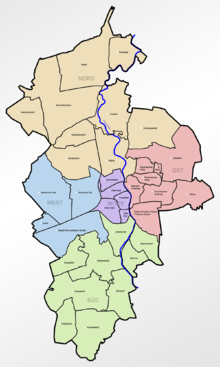
Boroughs and districts

Geological profile of the Zwickau coalfield
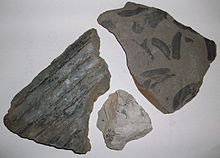
Fossils of the Silesium or Pennsylvanium (Upper Carboniferous)
City History
Origin
What is now western Saxony was settled by the Germanic tribes of the Suebi and Thuringians until the 6th century. From the 7th century Sorbs inhabited the area. In the 10th century, after the subjugation of the Sorbs by Heinrich I, the gradual Christianisation of the resident population took place and the immigration of German settlers began. The name "Zwickau" is probably derived from the Sorbian name Świkawa and - according to one theory - could go back to Svarozič, the Slavic god of the sun and fire: Coal seams still appear on the banks of the Mulden today. The Slavs probably already knew how to use coal. The name "Zwickau" could therefore mean "valley" or "floodplain of the god of fire". In the Topographia Superioris Saxoniae of 1650, on the other hand, it can be read that the area of the city foundation along the Mulden floodplain was called the "Swan Field" at that time. From this a Latinized town name Cygnau (also Cygnavia, Cygnea, lat. Cygnus = swan) was derived, which is also alluded to by the swans in the town's coat of arms.

enlarge and show information about the picture
![]()
360-degree-panorama from April 2011 with an overview of the city centre of Zwickau taken from the tower of the cathedral.
Medieval
From the Gau to the city
In 1118, the territorium Zcwickaw was mentioned for the first time in a document issued by Bishop Dietrich I of Naumburg in the monastery of Bosau near Zeitz. This is not a concrete place, but a Gau settled by Sorbs, the centre of which was the village of Osterweih. This settlement was later abandoned; it was located in today's northern suburb. Around this time, Countess Bertha von Groitzsch had Christianity introduced to the region and built St. Mary's Church in Osterweih.
Around the year 1150, the focus of the settlement shifted to today's inner-city area. A merchant settlement was formed around the Nikolai Church (near today's Nikolai School). This was located at the intersection of two important trade routes, the Böhmischer Steig salt road and the Polish track. The former led via Halle/Leipzig to Prague, the latter from Krakow via Saxony to southern Germany. Likewise, a settlement centre developed in parallel around St. Mary's Church and around the area of the later Wettin Electorate of Zwickau's Osterstein Castle with St. Catherine's Church.
It can be assumed that Zwickau received its town charter between 1192 and 1212. In a document from the year 1212, the designation of Zwickau as an oppidum (fortified larger settlement or town) can be found for the first time. In the document, which is dated 12 May, the Bishop of Naumburg confirmed the agreement between the Margrave Dietrich of Meissen and the Abbot of the Bosau Monastery, in which the latter waived claims against the town and town church in return for compensation of 250 marks.
The Zwickau Franciscan monastery with monastery school was first mentioned in 1232; it belonged to the Saxon Franciscan Province (Saxonia). The Cistercians established a farm in 1240, which was subordinate to the Grünhain monastery. Medical care is mentioned for the first time in 1266 with the later St. George and Margaret Hospital. In 1273 there was already a council, which marked the beginning of municipal self-administration. Since 1297 a mayor is provable.
Since the Mulde was easy to cross in Zwickau, important trade routes led through the city. Already in the 12th century, the High Trading Route, which led from Nuremberg via Hof, Plauen and Reichenbach near Zwickau to Bohemia, was of great importance. It promoted Zwickau's prosperity early on, so that from 1290 to 1407 the town rose to become a first-rate imperial city alongside Augsburg and Nuremberg. The founding of the Zwickau Latin School, which also became known as the Zwickau Grinding Mill in the late German Middle Ages due to its strict house rules, also dates back to 1290. In the same year, the towns of Zwickau, Chemnitz and Altenburg entered into an alliance. This came about on the initiative of the emperor and is documented by a deed. The emperor intended to curtail the influence of the sovereigns. The Castrum Zwickaw, the later Wettin Renaissance castle Osterstein, is first mentioned in 1292.
Mining began in the region in 1316, when Margrave Frederick the Bitten enfeoffed the town with a discovery pit in Fürstenberg (between Kirchberg and Weißbach). Silver and copper were mined here. As early as 1295 Zwickau had a moat and the town wall with the four town gates can be traced back to 1327.
In 1328 a fire destroyed large parts of the city, including St. Mary's Church and St. Catherine's Church.
The land law and the Zwickau customary law based on the Sachsenspiegel were codified in 1348 in the Codex Statutorum Zviccaviensium - the Zwickau town law book. Here one finds pictorial representations of the death penalty and the first craft regulations as well as the first mention of hard coal.
The devastating fire of 1403 destroyed almost the entire town. Margrave Wilhelm I then granted the town a seven-year tax exemption to facilitate reconstruction. In 1421 a beer ban was imposed on numerous villages in the vicinity of Zwickau, a ban on brewing beer. During the Hussite Wars, Hussites unsuccessfully besieged the town in 1430, but looted and burned down the suburbs and surrounding villages. The village of Osterweih, destroyed in the process, was not rebuilt.
Blood court of 1407
Due to the expansion of sovereign positions of power by Margrave Wilhelm I, who engaged the town judge Franz Steussing for his intentions in a conspiracy with the margravial bailiff Conrad Brückner and the councillor Nikel Hugk, a dispute arose with the Zwickau council. The withdrawal of municipal privileges by the sovereign resulted in an encroachment on municipal jurisdiction. Steussing abused his office as town judge and enriched himself with considerable damage to the town. After the death of Margrave Wilhelm I at the beginning of February 1407, the council had the opportunity to put Steussing on trial. In 19 articles the council set out the offences of Conrad Brückner and in 14 articles those of Franz Steussing in order to justify drastic action. Steussing was executed on 14 February 1407 on the main market square in Zwickau. Thereupon, on July 10, 1407, the new sovereigns had Mayor Peter Mergenthal and three councillors in Meissen beheaded under the Red Tower and buried in the cloister of the monastery of St. Afra in accordance with their status. In 1983 the graves with the skeletons of the four executed Zwickau councillors were found. The Zwickau city coat of arms adorned the grave slabs. This coat of arms shows not only the towers but also the swans. This proved that the swans were already part of the Zwickau coat of arms around 1400. The towers, on the other hand, decorate the coat of arms verifiably since 1290. In the State Museum for Archaeology in Chemnitz, the event of 1407 is mentioned.
Silver, coins, privileges
In 1444 the town regained its jurisdiction. The Schneeberg silver deposits were discovered in 1470. Their exploitation was mainly in the hands of the Zwickau patricians, including the Amtshauptmann Martin Römer and his brother Nicol, Hans Mergenthal, Hans Federangel and other Zwickau merchants.
Emperor Frederick III granted the city the red seal privilege in 1473. The red seal colour was in itself reserved only for the emperor, important state officials or ecclesiastical dignitaries (cardinals). Since then, deeds and official documents were sealed with red wax by the council. This privilege was also represented by the city colours (red and white).
The Zwickau mint was founded around 1440. It was in operation with interruptions until 1493. It was here that the first Saxon coins with the effigy of a ruler were struck from 1492 to 1493. These groschen coins with the name "Bearded Groschen" show the bearded bust of Elector Frederick III. The Zwickau Bearded Groschen and the subsequently minted interest groschen of equal value in Schneeberg served to prepare the first Saxon silver florins (thalers) minted in Annaberg and probably also in Wittenberg.
The Ernestine Elector Frederick III, called Frederick the Wise, described his Zwickau as the pearl of the Electorate of Saxony.
When Duke Albrecht of Saxony set off on a pilgrimage to Rome and Palestine in 1476, the Zwickau patricians Martin Römer and Landrentenmeister Hans Mergenthal were also in his entourage. Martin Römer died in 1483 as a generous patron of his town - among other things, he was the builder of the Zwickau granary next to Osterstein Castle. In 1477 he had the Great Pond built as a fire-fighting pond and for fish farming. It was not until the middle of the 19th century that it was given the name Swan Pond.
The Nuremberg painter Michael Wolgemut (teacher of Albrecht Dürer) created the winged altar of St. Mary's Church in 1478. Since 1486 Zwickau had two pharmacies: The Löwenapotheke and the Salomonisapotheke (herbal vault). Both houses still stand today on the main market square diagonally opposite the historic town hall. The famous Zwickau carver Peter Breuer was granted citizenship in 1504. Numerous works in the churches of Zwickau and the surrounding area originate from his hand. In particular, his Pietà "Lamentation of Christ" in Zwickau's Mariendom is a well-known work of art.
The town is also home to works of art by one of the most famous artists in Electoral Saxony between the late Gothic and Renaissance periods, the stonemason and sculptor Paul Speck. These include, in the city centre, the pulpits and baptismal fonts of St. Mary's Cathedral, St. Catherine's Church and, here directly opposite, the portal of the Posthalterei.
The foundation of the Zwickau City Archives dates back to 1487, when Elector Frederick the Wise and his brother Duke Johann requested the Zwickau Council to set up a fireproof vault "with iron doors and three good locks" for them and their cousin Duke Albrecht, in order to store important documents for both sides. Old treasures from the Middle Ages, such as manuscripts, incunabula, documents, letters and books, are archived here, including the Hans Sachs volumes of the Nuremberg Meistersinger (1494-1576). Of the twenty-one volumes of his Meisterlieder still extant worldwide, fourteen volumes, two quarto and six folio volumes of Meistergesänge (MG 2, 3, 4, 5, 8, 12, 13 and 15), six folio volumes of Spruchgedichte (SG 4, 11, 12, 13, 16 and 18) as well as Sachs's catalogue raisonné are present here.
In addition to the city archive, Zwickau also has one of the oldest libraries in the entire Upper Saxony region in the form of the council school library. Its historical roots go back to the establishment of the Zwickau Latin School at the end of the twelfth century. Its holdings contain around 250,000 different items, including, for example, the Zwickau manuscripts, including the oldest manuscript from the 9th century. Among the 6000 volumes from the estate of the Zwickau chief town clerk and councillor Stephan Roth (1492-1546) are also many university theses, printed unique items and musical materials. Both the pedagogue and orientalist Johann Zechendorf (1580-1662) and Rector Christian Daum (1612-1687) left further extensive collections to the Council School Library. This institution, which also serves international specialists in scientific historical research in particular, was housed in the east wing of the newly built König-Albert-Museum in 1914, which later became the Zwickau Municipal Museum. The institution has had online access since January 2011.
Elector Friedrich the Wise and his brother Duke Johann renewed the Zwickau minting mandate in 1490. Due to demands of the bakers, the local grain mills received bag gears in 1502 - the first documented use of this technology. In 1505 the council received church patronage from the Eisenberg monastery. Zwickau had the brewing privilege and the citizens entitled to brew had been building mountain cellars for beer storage since 1511.
Modern Times
Reformation
In Zwickau, witch hunts were carried out from 1424 to 1629: 14 people fell victim to witch trials, three were executed.
In 1516 the citizens refused to pay homage to the new council. In 1519 Georgius Agricola (1494-1555) founded the Greek school, which he united with the Latin school one year later. From 1519 to 1523 he was rector of the then well-known Zwickau council school.
Thomas Müntzer preached in Zwickau from October 1520 to April 1521; he came here on the recommendation of Martin Luther. In 1520, Luther dedicated his treatise Von der Freiheit eines Christenmenschen (On the Freedom of a Christian) to his friend, the Zwickau mayor Hermann Mühlpfort. Thomas Müntzer joined the "Zwickau prophets", who were later opposed by Luther as "enthusiasts". Zwickau citizens stormed the Grünhain monastery courtyard in March 1522 to free captured peasants. There were iconoclasts.
In April 1522, Martin Luther came to Zwickau at the request of the council and preached a few sermons. Here he escaped an assassination attempt by finding refuge in an inn. There he uttered the saying, "This is my paradise." The inn henceforth bore the name "Zum Paradies". The adjacent Mulden bridge is therefore also called "Paradiesbrücke". Also today the steel rivet bridge, which was newly built on the spot around 1900, bears this name. The old inn, however, was demolished in the course of a so-called "socialist urban redevelopment".
The pastor Nikolaus Hausmann was the first to profess the Lutheran Reformation in Zwickau in 1523. The Franciscans were expelled from the city. Hans Schönsperger from Augsburg established the first printing press in the city in 1523. Under his successor Gabriel Kantz at the latest, Zwickau became an important center of Reformation publications. Zwickau was thus also called "the stronghold of the Reformation". In 1525 there were peasant uprisings in the Zwickau area. Pastor Hausmann obtained the pardon of 80 rebels from Elector Johann.
Zwickau was the centre of the cloth makers in the Electorate. "Zwicksches Tuch" was a household name beyond the borders of Saxony. The clothiers began building the Gewandhaus on the Hauptmarkt in 1522; it was completed three years later. After the Oberhohndorf coal deposits were discovered in 1530, coal mining began on a larger scale than before.
Around 1540, about 10,000 inhabitants lived in Zwickau. 230 of them were master clothiers.
Differences of opinion between the Ernestine Elector John the Steadfast and the Albertine Duke George the Bearded led temporarily between 1530 and 1533 to the recommissioning of the disused Zwickau mint. After the restoration of the minting community, the Wettins united the Zwickau mint with the Schneeberg mint in 1534.
Leipzig Partition
Starting from the Saxon fratricidal war via the Altenburg prince robbery, it came to the Leipzig partition of 1485. Afterwards, Zwickau continued to belong to the electorate (Ernestine Saxony/Thuringia) of Elector Johann Friedrich I. In the Schmalkaldic War, the city was occupied in January 1547 by the troops of the Albertine Duke Moritz, plundered, burned down and the inhabitants expelled. Although Moritz was a Protestant like his Ernestine cousin, he supported the army of the Catholic Emperor Charles V. In the event of the victory of the imperial troops, Duke Moritz counted on the award of the electoral dignity. The Schmalkaldic War ended with the surrender of Wittenberg. Afterwards, Albertine Saxony was granted the electorship by the Emperor at the Diet of Augsburg in 1548. At the same time, it was decreed that the city of Zwickau would be detached from Ernestine Saxony and annexed to what was now Electoral Albertine Saxony (Dresden/Meissen). As a result, Zwickau is the only large city in Saxony that belonged to the Electorate without interruption until the end of the Holy Roman Empire in 1806. The electoral Saxon office of Zwickau had been part of the Erzgebirgischer Kreis (Ore Mountains District), which was detached from the large Meissen district, since 1691. Due to its convenient location, the town became an administrative centre of the Erzgebirge.
From Luther's friend and companion Melanchthon, one of the great humanists of modern times, the following Zwickau quote has come down to us:
"Zwickau has always been a pearl in these lands, because it watches over discipline and manners with greater rigor than most other cities, and because it is fertile in many talents and has had and still has many citizens who excel in their education, so that they are an ornament to all of Germany. In art and science Zwickau surpasses all the cities of these lands."
- Philipp Melanchthon, 1548
Zwickau had the privilege of calling itself a "churfürstliche Stadt" (electoral city) until the foundation of the Kingdom of Saxony in 1807. The seven red and white flags on the electoral hat of the town's coat of arms represent the seven electorates of the Holy Roman Empire. Although the city was hit by a severe flood in August 1573, the Great Princely Shoot took place at the end of the month, which was attended by the Saxon Elector and numerous high guests from almost all parts of the empire.
Thirty Years War until 1918
During the Thirty Years' War (1618-1648) Zwickau was besieged nine times. Wallenstein, general of the imperial troops, demanded contributions in kind and money from the town. After the Peace ofWestphalia in 1648, Zwickau had to pay a peace money of 2063 talers to the Swedes. The war burdens amounted to a total of 321,141 thalers.
During the Seven Years' War (1756-1763) Zwickau was exposed to changing occupations by Prussians, Austrians and the Imperial Army. The citizens had to suffer from quartering and high tribute payments. Zwickau had to pay 557,664 Taler to Prussia alone until the 19th century.
On 16 May 1812, Emperor Napoleon and his wife Marie Louise took up quarters in Zwickau. The emperor was welcomed by the people of Zwickau with the ringing of bells, a parade of marksmen and citizens standing on guard.
In 1835, in the Kingdom of Saxony, which had been divided in half since the Congress of Vienna in 1815, the Erzgebirge district was dissolved and the town became part of the district administration (since 1874 district administration) of Zwickau.
From February 26 to March 2, 1830, the Zwickauer Mulde was flooded by the worst icefall in centuries.
In the middle of the 19th century the city wall was demolished and the moat was filled in. Streets were laid out on the filled-in moat. These initially bore different names (Moritzgrabenweg, Schulgrabenweg, Mühlgrabenweg, Schloßgrabenweg).
The National Socialist era and the Second World War
On 11 October 1921, the locksmith Fritz Tittmann founded the first NSDAP local group outside Bavaria in Zwickau. During the Third Reich, honorary citizenship of Zwickau was also awarded to high-ranking National Socialist politicians.
During the Nazi period before 1935, the Grabenwege were combined into a city ring encircling the inner city and renamed the Adolf Hitler Ring.
A concentration camp was temporarily set up in Osterstein Castle from 1933 to 1934. Up to 750 people were imprisoned here, mainly Social Democratic and Communist critics of the regime. The first secretary of the KPD sub-district leadership, Martin Hoop, was murdered here on the night of 10-11 May 1933. A subcamp of the Flossenbürg concentration camp was set up in the three Auto Union plants (Horch main plant, Dorotheenstraße plant and Audi plant) for the production of military vehicles for about 3000 forced labourers. Among them were prisoners of war as well as concentration camp inmates. Zwickau commemorates these victims with memorials or exhibitions.
In the course of the pogrom night of November 9-10, 1938, apartments of Jewish citizens in Zwickau were destroyed, a meeting place on the ground floor of Burgstraße 10 and the chapel of the Jewish cemetery were set on fire.
→ Main article: Air raids on Zwickau
During the air raids in World War II, Zwickau, unlike other major Saxon cities such as Leipzig and Dresden, was not heavily destroyed by area bombing. After targeted attacks on armaments factories and transport facilities, such as the Gustav Basser KG aircraft repair works at the Zwickau airfield on Reichenbacher Straße (12 May 1944) and the Reichsbahn repair works and the Auto-Union Horch and Audi factories (7 October 1944), the city centre was a direct target only on 19 March 1945. The explosion of an aerial mine damaged the south side of St. Mary's Church ("Zwickau Cathedral") and surrounding residential buildings. After the war, significantly damaged historic buildings in the city center were demolished. In total, 5% of Zwickau was destroyed. 591 people lost their lives in the air raids (including Planitz and Cainsdorf).
The air-raid police officer Arno Rau saved Zwickau from the planned total destruction by raising the white flag on the tower of St. Mary's Church in the evening hours of April 17, 1945 and causing the church bells to ring. Thereupon, the planes turned away, and units of the US Army advanced to the Zwickauer Mulde without a fight.
Occupation
The town centre, located on the western bank of the Mulde, was occupied by the 3rd US Army on 17 April 1945. The strictly guarded demarcation line between the occupation area of the Red Army and the US Army ran along the Zwickauer Mulde. It was forbidden to cross the Mulde. Here they fired live rounds. To get from the eastern to the western part of the city, resourceful citizens used the underground paths of the coal shafts. After the agreements of the Yalta Conference, the whole district of Zwickau was finally annexed to the Soviet Occupation Zone. The 3rd US Army withdrew its forces from West Saxony to Bavaria and from 1 July 1945 Zwickau was occupied by the Red Army.
In the context of the uranium mining of the SAG Wismut for the Soviet nuclear weapons development, which started in the Westerzgebirge in 1946, Zwickau became an important processing and supply centre for this branch of industry.
GDR times
The former Adolf Hitler Ring was given the name Dr.-Friedrichs-Ring after the death of the Saxon politician Rudolf Friedrichs.
On 25 July 1952, as part of the district reforms in the GDR, the city became part of the district of Karl-Marx-Stadt (until 9 May 1953 and from 1 June 1990 Chemnitz district). The then Zwickau district was dissolved and divided into the districts of Auerbach, Reichenbach, Schmölln, Stollberg, Werdau and Zwickau-Land (main part).
A severe flood in mid-July 1954 inundated large parts of the city centre, the old town almost completely. On the square in front of the Gewandhaus, the water was so high that about two thirds of the ground floor windows of the building were covered by water.
In 1960 Zwickau was hit by a serious mining accident. There was an explosion in the "Karl Marx" coal mine which killed 123 miners. In 1978, hard coal was mined for the last time.
On the Windberg near Zwickau the central pioneer holiday camp "Karl Liebknecht" was built and operated as a tent city.
Development since 1989
With the reunification of Germany and the accession of the GDR to the Federal Republic of Germany on 3 October 1990, Zwickau once again belonged to the state of Saxony.
When the county reform law came into force in Saxony on August 1, 1994, the two former counties of Werdau and Zwickau were united to form the county of Zwickauer Land. The district seat became Werdau. The city of Zwickau still retained its status as an independent city.
As part of the Saxon district reform on 1 August 2008, the city was deprived of its district status. Zwickau was given the rank of a large district town and became the administrative seat of the now significantly enlarged newly formed district of Zwickau, which was formed from the independent city of Zwickau and the former districts of Chemnitzer Land and Zwickauer Land.
Shortly after 3 p.m. on November 4, 2011, there was an explosion and subsequent fire in a residential building at Frühlingsstraße 26 in Zwickau-Weißenborn. As it later turned out, Uwe Böhnhardt, Uwe Mundlos and Beate Zschäpe, right-wing terrorists of the National Socialist Underground, had gone into hiding in this house for several years. According to the police investigation, Beate Zschäpe triggered the explosion when the media reported the death of the two accomplices in Eisenach. The house was demolished half a year after the explosion. A memorial to the ten NSU victims in the form of ten trees and associated memorial plaques has existed since 3 November 2019, after a first tree planted on 8 September 2019 was sawed down by unknown persons just a few weeks later.
Population development
→ Main article: Population development of Zwickau
After the opening of the inner-German border in autumn 1989, Zwickau suffered a sharp drop in population. An eleven-storey high-rise building of the employment agency on Leipziger Straße was therefore completely oversized for this purpose from the outset. After the historic Gründerzeit building of the cotton spinning mill in Zwickau-Pölbitz had been restored with private investment funds in 2006, the employment agency moved in. The initial departure of young, well-educated people due to the threat of unemployment was also linked to the closure of five major Zwickau companies after 1990. In addition, the city could not escape the general demographic negative trend; in the new federal states, the number of newborns dropped dramatically after 1990. Another reason for the population decline was the increasing suburbanisation. Many Zwickau residents have moved to the outskirts of the city since reunification. As a result, Zwickau has the highest annual average number of relocations in Saxony. Similar to other large cities in Germany, Zwickau is now surrounded by a so-called "Speckgürtel". Thus, the district of Zwickau still has by far the highest population density of all Saxon districts. By investing in jobs, in day-care places for children, in urban redevelopment and in the renovation of historic buildings, the process has been slowed down considerably in recent times. According to information from the municipal statistics office on the migration of the Zwickau population, it already reached a balanced balance in 2009.
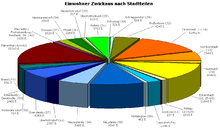
Population by city districts (as of May 2009)
.jpg)
Wilhelminian architecture: Employment agency

The devastating high water and flooding of the city centre on 10 July 1954.

The population growth of the late 19th century in the Bahnhofsvorstadt resulted in the construction of the Luther Church (1902-1906).
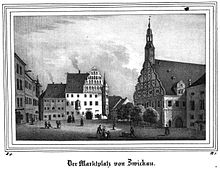
Today's main market around 1835
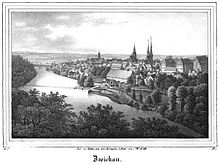
Zwickau before 1839
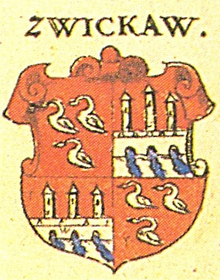
The old Zwickau coat of arms from the Siebmacher coat of arms book sheet 221 published in 1605

Gewandhaus

The Thomas Müntzer Monument (Jürgen Raue, 1983) in front of St. Catherine's Church in Zwickau
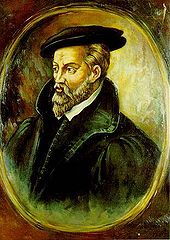
Georgius Agricola
.jpg)
Part of the medieval city wall and powder tower
Search within the encyclopedia